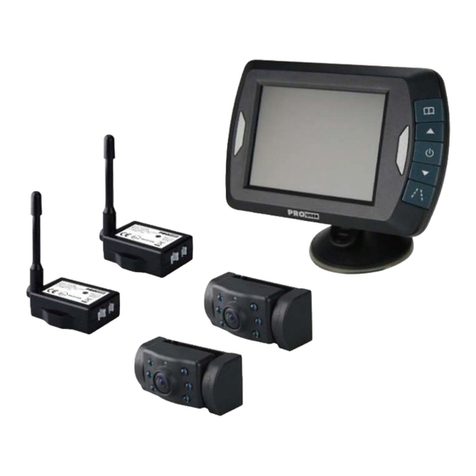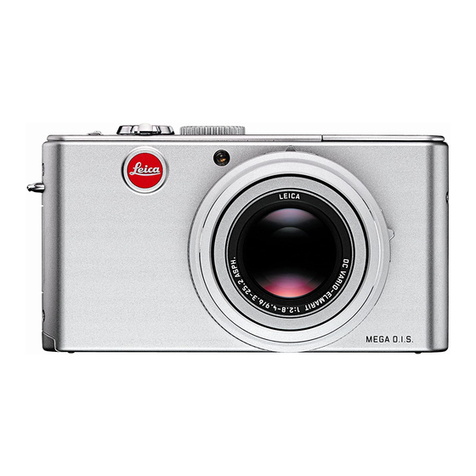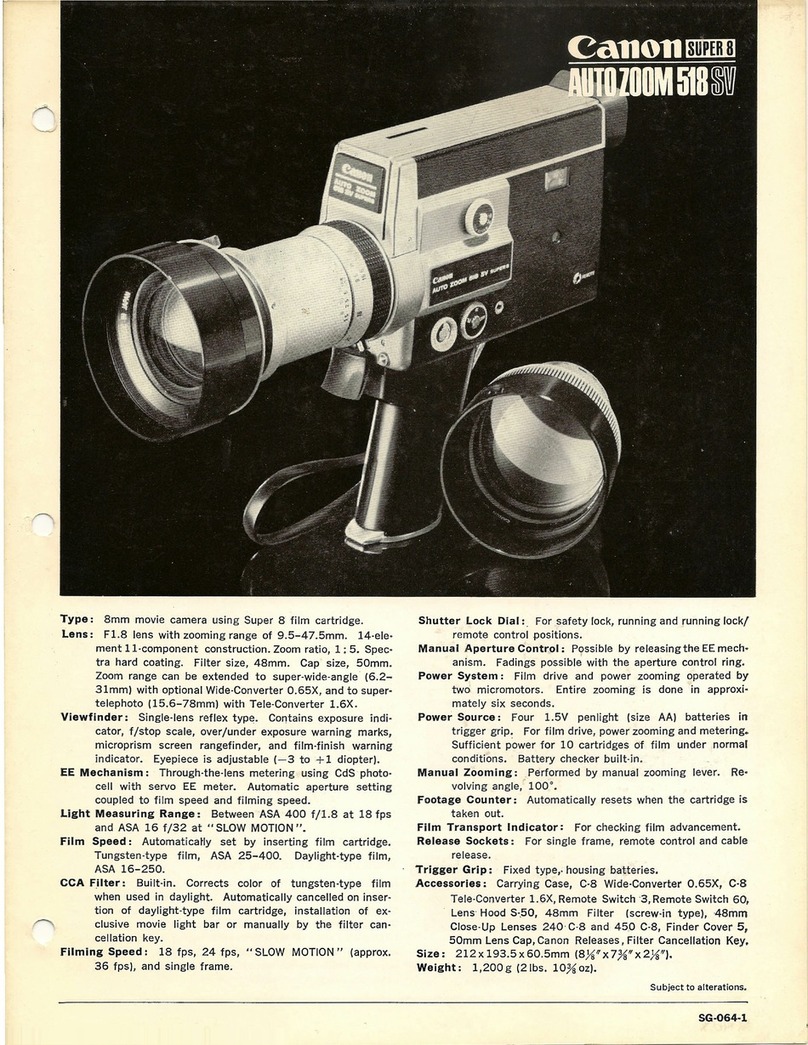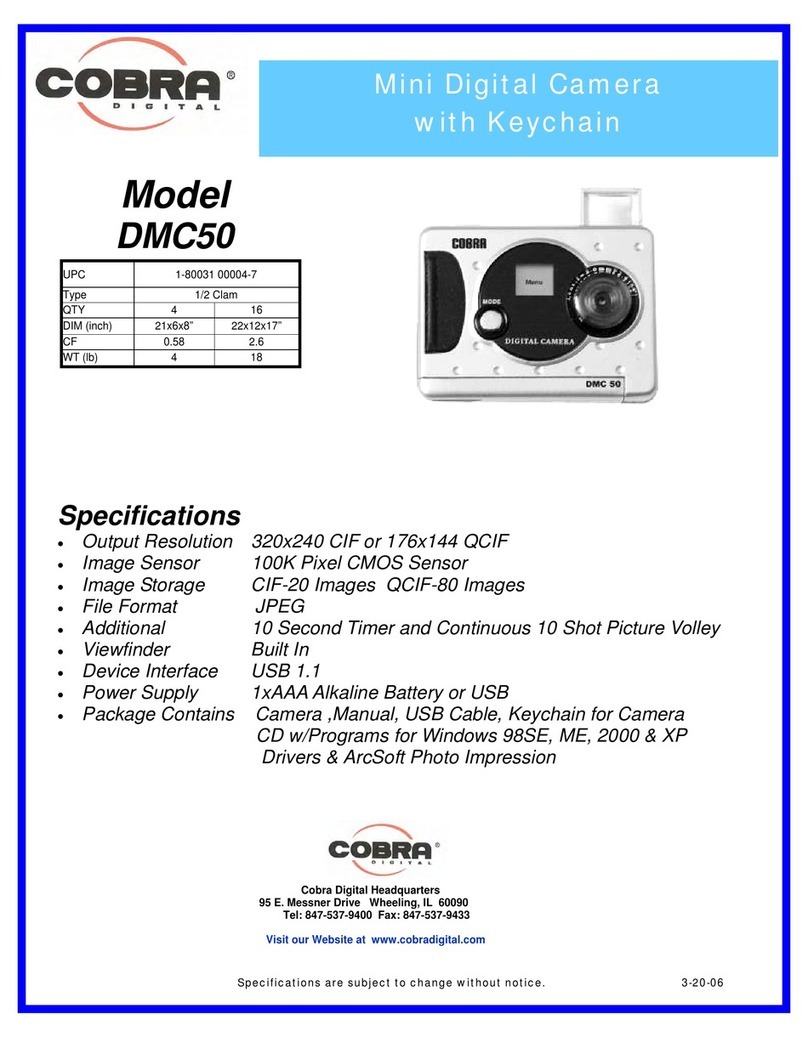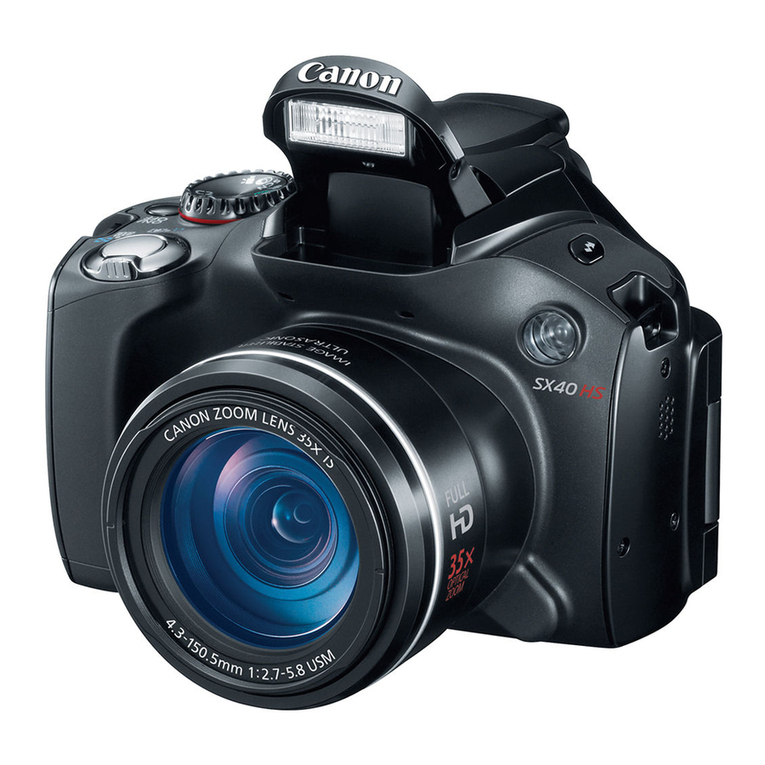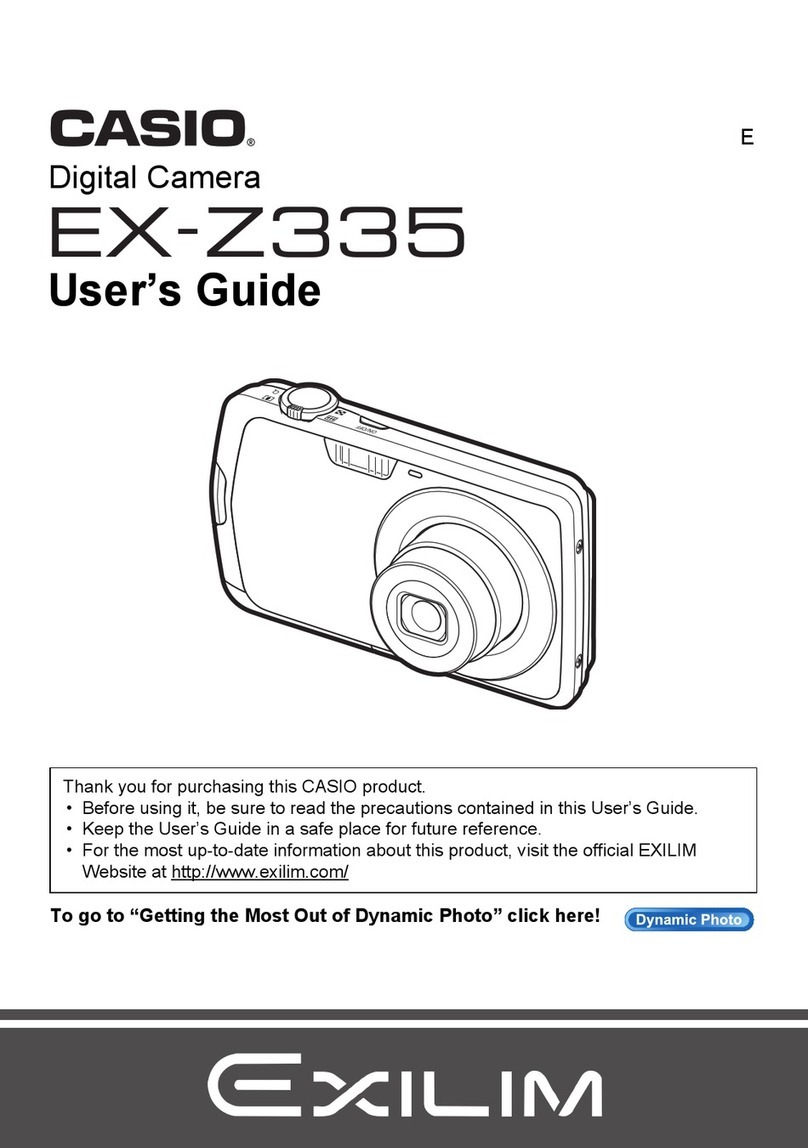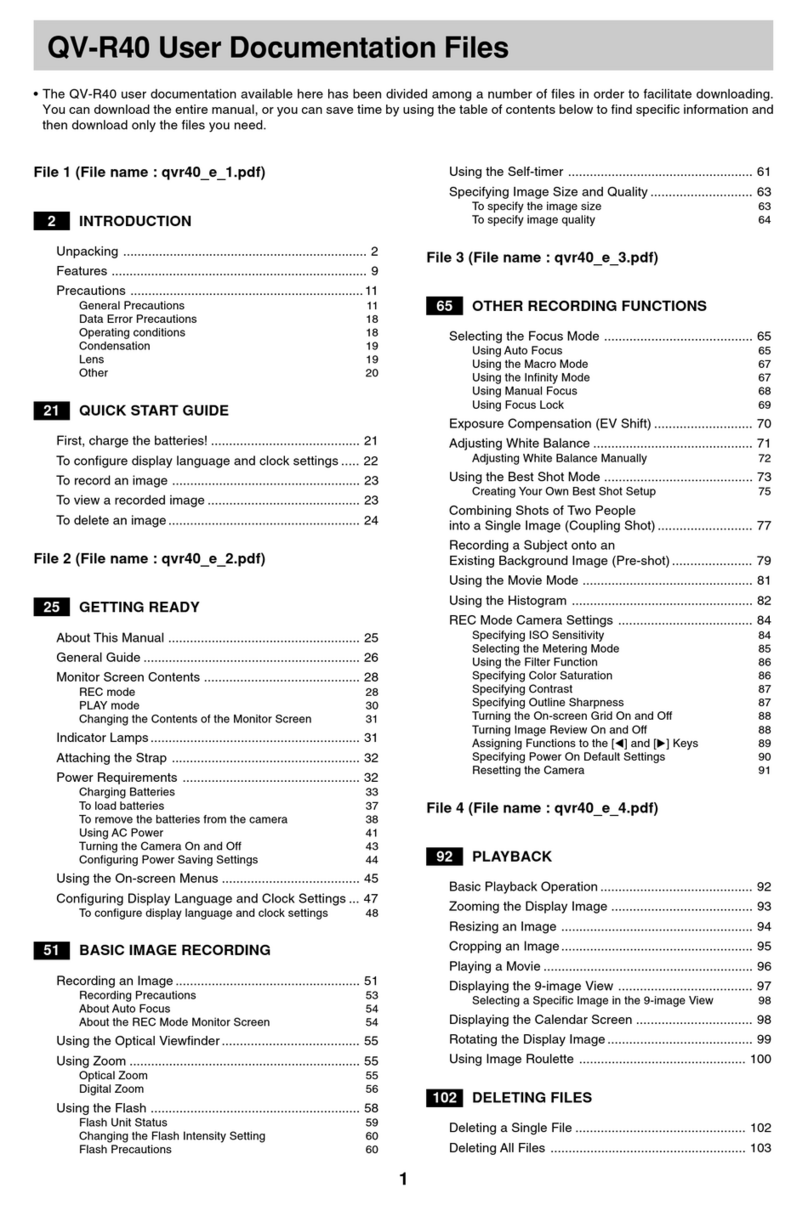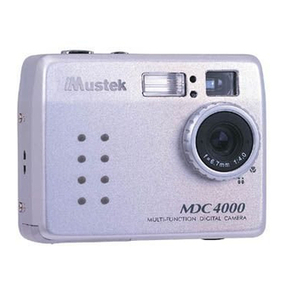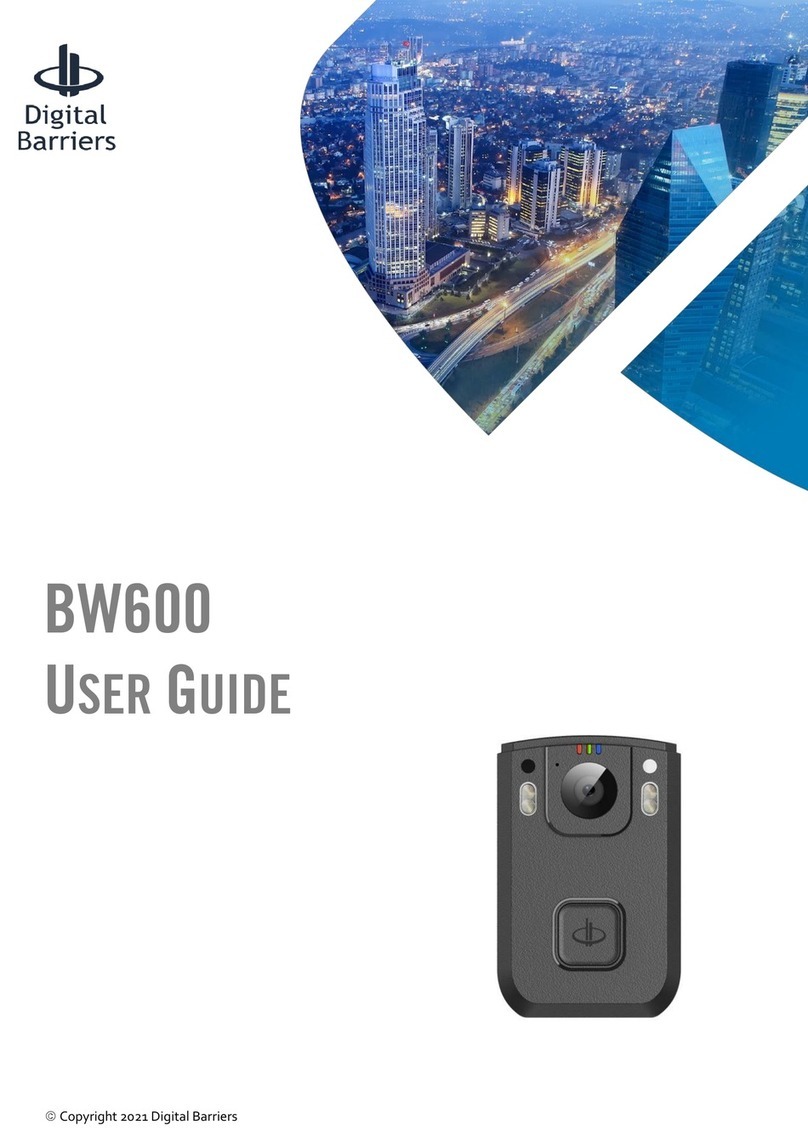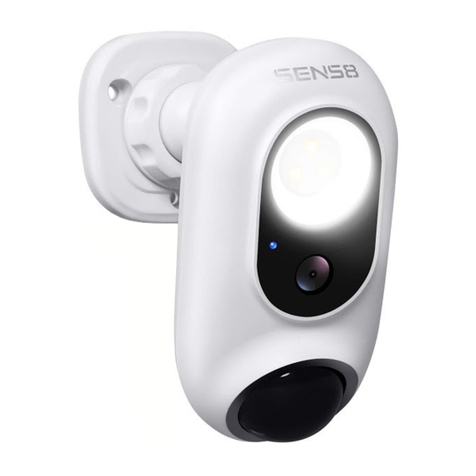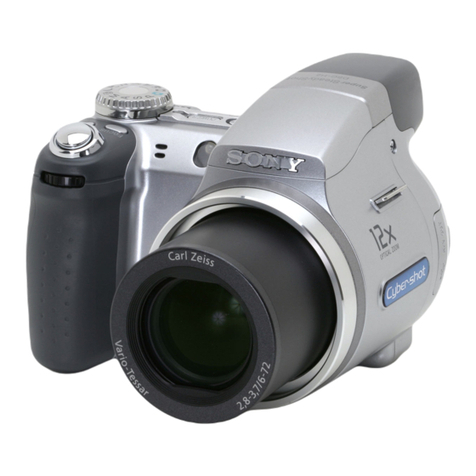pro user APR043DC User manual

2 IN 1 WIRELESS BACKUP CAMERA SYSTEM &
EVENT RECORDER
2 IN 1 KABELLOSES RÜCKFAHR-KAMERA-
SYSTEM & EVENT RECORDER
2 EN 1 SYSTEME DE CAMERA DE RECUL SANS
FIL & CAMERE DE SECURITE ROUTIERE
2 IN 1 DRAADLOOS ACHTERUITRIJCAMERA
SYSTEEM & DASHBOARDCAMERA
with / mit / avec / met 12cm / 4.3” monitor
APR043DC
CE 0560

2
INTRODUCTION
The Pro-User APR043DC is a member of the family of advanced car backup systems
manufactured by Pro User.
The Pro-User Wireless Backup Camera and Monitor, will improve your ability to see
behind your car, camper, trailer, or mini-van. It will also enable you to keep your car and
the traffic under surveillance with the integrated dashcam. We have taken numerous
measures in quality control to ensure that your product arrives in top condition, and will
perform to your satisfaction.
Please carefully read and follow the following safety and operating instructions.
IMPORTANT SAFETY INSTRUCTIONS
Before You Install
If you are not confident working with 12 volt DC vehicle wiring, removing and reinstalling
interior panels, carpeting, dashboards or other components of your vehicle, contact the
vehicle’s manufacturer, or consider having the camera system professionally installed.
Interference
This device, as well as all other wireless devices, may be subject to interference.
Interference may be caused by cell phones, Bluetooth headsets, Wi-Fi routers, power
lines and other various electrical equipment, etc.
Repair
The camera system is maintenance-free and must not be opened. Any attempt at
modification or repair by the user will result in a loss of guarantee.
Regulations and Usage restrictions
Please make sure that it is allowed to use this device, especially the dashcam, in the
country your are using it. Please do not record the privacy of individuals at any time and
do not intend presenting the videos made to third parties or the public.

3
PARTS
1. Monitor with integrated dashcam 2. Camera with mounting plate
3. Transmitter Box 4. Mounting Accessories
5. Monitor Power Cable 6. Transmitter Box Power Cable

4
INSTALLATION
These instructions do not apply to all vehicles. They are only meant as a general
guide due to the number of different makes & models. For vehicle specific
questions contact your vehicle’s manufacturer.
Camera installation
There are several ways to mount the camera on the back of your car. But the most
convenient is to mount it near the license plate of the car. Supplied is a mounting plate
that can be fixed behind the license plate. The camera itself can be fixed on this
mounting plate.
The camera can be tilted vertically to adjust the viewing angle. Make sure that its field of
view and detection are not obstructed.
At some type of cars it is not possible to mount the camera near the license plate. You
may have to find another spot at the back of your car to mount the camera.
1. Remove the rear license plate, and then loosen the license plate bolts/screws.
2. Position the supplied mounting plates (with camera together) behind the license plate
bracket. Secure both license plate bracket and mounting plates with the license plate
bracket bolts/screws.

5
3. Mount the license plate on the license plate bracket.
4. Choose a routing path for the camera’s power cable through the vehicle’s body to the
reverse light circuit. If in doubt, seek professional installation assistance.
5. Some vehicles may have a hole available to pass the wire through, such as where the
license plate light is mounted, or you can drill a hole close to where the power cable
is attached to the camera. Once you have chosen where the cable will enter the
vehicle’s body, remove the camera. If you are able to use an existing opening, skip
the next two steps.
6. Remove the license plate and camera before drilling. ATTENTION: Before drilling
any hole, remove the camera and the licence plate and carefully examine the
area around and behind the installation position. Make sure that there are no
parts that can be damaged (especially electrical cables, components of the
vehicle´s fuel system or any liquid tanks). Please take every reasonable
precaution. Choose a drill that is suitable for the supplied grommet and
material.
7. After you have drilled the hole, insert the supplied grommet, then pass the camera
cables through the grommet into the vehicle. You must use the grommet to prevent
the metal edge of the hole from cutting the camera cable.
8. Mount the transmitter box inside the trunk. Connect the camera’s power cable and
the transmitter box power cable to the transmitter box.
9. Next you’ll need to find the vehicle’s backup lights. Turn the vehicle’s ignition key to
the accessory position, engage the parking brake and go into reverse. Look at the
vehicle’s tail lights to see where the reverse lights are located (usually the white
lights). To locate the backup light’s 12V/24V (+) wire, it probably will be necessary to
gain access to the rear of the vehicle’s taillight. For help locating the vehicle’s reverse
light circuit contact your vehicle’s manufacturer for vehicle specific wiring diagrams.
10. Once you have located the reverse light circuit you will have to route the transmitter
box power cable to that location. You must securely fasten the power cable to prevent
it from being caught on any vehicle component such as the trunk hinge. Never route
the cable on the outside of the vehicle!
11. The reverse light sockets on most vehicles
have two wires connected to them. Usually
the negative wire is black and the positive
wire is a colored wire. If you are uncertain
about the wiring, you can use a 12 volt
multimeter available at most auto parts
stores to determine which is the positive wire.
Follow the manufacturer’s instructions for the
safe use of the multimeter.

6
12. After determining which wire is the positive and which is the negative, turn off the
ignition key and remove the battery’s negative cable (ground -).
13. Splice the red wire using the supplied in-line wire connectors to the reverse light’s
positive (+) wire. Use a set of slip joint pliers to squeeze the TAP and insure good
connection.
14. Next splice the black wire of the transmitter box power cable to the reverse light’s
negative (-) wire or ground.
15. Replace the reverse light bulb, and then re-install the light socket. Secure all the
wires with cable ties or electrical tape.
16. Re-attach the negative battery cable to the battery.
Monitor Installation
When choosing a location to mount the monitor, make sure the
monitor is in an area that will not obstruct your vision while
driving.
1. Before mounting the monitor, clean the mounting surface
well.
2. Position the suction mount to the smooth surface which suits
your requirement.
3. Press the suction cap against the smooth surface and press the lock down to attach
and fix the mount to the surface. Snap in the monitor to the suction mount.
4. Adjust the mounting arms to suit your view angle to the monitor and tighten the
screws on the mount to fix the position.
5. Route the power cable to the vehicle’s cigarette lighter socket/12V power outlet. The
cable must not interfere with the safe operation of the vehicle.

7
6. Insert the small 12 Volt DC plug of the power cable into the right side of the monitor.
7. Plug the 12 Volt cigarette lighter plug into the vehicle’s cigarette lighter socket. To
maximize the effectiveness of the suction mount, it is recommended that the
application be performed under the following conditions:
•Surface temperature should be between 21 and 38 degrees Celsius.
•Application below 10 degrees should be avoided.
•Application should not occur in direct sunlight.
Mounting should be protected from exposure to direct sunlight for a period of 24
hours.
Testing the System
1. Check if the vehicle’s negative battery cable (ground) has been reattached.
2. Turn the ignition key to the accessory position - do not start the vehicle.
3. Engage the parking brake, and put the vehicle´s shifter in the reverse position. The
System should activate itself. If not, press the Power-button on the Monitor.
4. If not already done: Please pair your camera(s) to the monitor (as described in
chapter OPERATION)
5. After testing (and re-adjusting if needed) the unit, all cabling should be installed
permanently: Route all wires behind interior panels or under carpeting. Use the
supplied cable ties to keep excess wires neat and compact.
NOTE: UNDER EXTREME BRIGHT LIGHT CONDITIONS, THE SCREEN IMAGE MAY
TAKE A FEW SECONDS TO STABILIZE. PLEASE WAIT UNTIL THE IMAGE HAS
STABILIZED BEFORE BACKING UP.

8
OPERATION
This backup camera system has 2 built-in video systems.
A. Backup Camera (Reversing Camera): It will improve your ability to see behind
your vehicle.
B. Event Recorder (Dash Cam):a built-in battery supports up to 5 minutes of
recording time after a power cut off.
Once the vehicle is in reverse, the backup camera mode will be forced to start and
the monitor will display the image of according camera.
Press the Power/Enter-button shortly for turning on, press it long to switch off the
monitor.
When the monitor image is on, the blue LED will be lit. When the monitor image is OFF,
the blue LED will blink on and off.
General Usage
Select the desired menu item by using the Up/Down-buttons. Then confirm your choice
with the Enter button. Press the Menu-button to exit a submenu or wait a few seconds
without any input to exit automatically.
Menu / Back
Up / Record
Power / Enter
Down / Playback
Lines

9
A. Reversing Camera Mode (when car is in reverse)
Press the Menu/Back-button to enter the settings page.
Brightness
Contrast
Color
Rotate
Example: To change the orientation of the displayed image, select the “Rotate” icon and
choose your desired screen orientation.
Lines-button
This camera system has the option to show guidelines on the display. This may help you
to visually estimate the distances between objects and your car. By pressing the Lines
button, you can switch this option on and off.
B. Event Recorder Mode (availabe only when not in reverse)
•Page up/ Record-button:Press this button short in Event Recorder mode to
start and stop the recording. When watching the recorded video, press for fast
forward and fast backward.
•Page down / Playback-button:Press this button in Event Recorder mode to
enter the “playback” page in order to select a recorded video.
Press “Menu / Back”to enter the setup page and chose one of the following:
Display setup
Dashcam setup
Use the Up/Record-button or Down/Playback-button to select.
Use the Power/Enter-button to enter and confirm.
Use the Menu-button to go back to Menu.

10
Menu
Display setup
Brightness
Contrast
Colour
Dashcam setup
Recording
Recording setup
Setup
System setup
Playback
Playback: Select and play a
recorded video

11
Recording Setup:
The maximum size of a video file is 256Mb, once this size is reached, the system will
automatically start to build a new file for recording.
Recording setup
Size
Video Resolution:
VGA (640*480) / HD
(1280*720)
Record mode
Record mode selection:
AUTO start / Manual record /
Motion detection
Overwrite
When the SD card is full, old
recorded videos will be
overwritten
Time Stamp
Informations displayed on the
recorded video:
OFF / Date only / Date &
Time
MIC
Audio record ON / OFF

12
System Setup:
System setup
Format
Format SD Card
Language
Language selection
Auto off
LCD display Auto off:
1 Min / 3 Min / 5 Min / Off
System reset
Back to the factory settings
Date
Set Time/Date format
Version
Software Version
Playback:
All recorded videos will be displayed here and can be selected to be played. Long press
the “Menu” button to display the following options:
Playback Setup
Delete
Delete Single/All recorded
video
Protect
Protect or unprotect Single/All
recorded video.

13
TECHNICAL SPECIFICATIONS
Camera
Operating Voltage
8-15V DC
Current consumption
<150mA
Sensor Type
CMOS
Resolution
640x480
Optical lens
2,4mm / F2,1
Wireless transmitter
Transmission frequency
2414MHz
RF transmission distance (open space)
≥60 m
LCD monitor
Operation Voltage
8-15V DC
Standby Current
≤10mA
Operation Current
≤350mA
LCD display screen size
12cm / 4.3 inch
Resolution
480x272
CMOS Lens Resolution
HD 720P
Environmental Temperature
-10 to +50 degree Celsius
General:
Micro SD Card (not included)
Above Class 4, up to 32GB
USB
USB 2.0
This model may be operated in EU countries.
CE0560
ENVIRONMENTAL PROTECTION
The product is classed as Electrical or Electronic Equipment and should not
be disposed of with other household or commercial waste at the end of its
working life. Please recycle where facilities exist. Ask your local authority or
retailer for recycling advice.
WARRANTY
Pro-User warrants this product for a period of 2 years from the date of purchase to the
original purchaser. Warranty is not transferable. Warranty covers defect against
workmanship and materials only. To obtain warranty service, please return the unit to
the place of purchase or authorized Pro-User dealer together with your proof of purchase.
The warranty is void if the product has been damaged or not used as described in this
manual. Warranty is void if a non-authorized repair has been performed. Pro-User makes
no other warranty expressed or implied. Pro-User is only responsible for repair or
replacement (at Pro-Users’ Discretion) of the defective product and is not responsible for
any consequential damage or inconvenience caused by the defect.

14
EINLEITUNG
Der Artikel Pro-User APR043DC gehört zur Familie der zukunftsweisenden Auto-Rückfahr-
Kamera-Systeme der Firma Pro-User-International Ltd.
Die kabellose Pro User Rückfahr-Kamera mit Monitor ermöglicht es Ihnen hinter Ihr Auto,
Ihren Anhänger oder Mini-Van zu sehen. Auch haben Sie die Möglichkeit mit der
Frontkamera das Umfeld des Fahrzeuges bzw. den Verkehr als Videodatei aufzuzeichnen.
Permanente Qualitätskontrolle stellt sicher, dass Sie ein hochwertiges Produkt erhalten,
dass Ihnen hohe Zuverlässigkeit und Funktionalität bietet.
Bitte lesen Sie die Bedienungsanleitung sorgfältig durch und folgen Sie den
Sicherheitshinweisen und der Montageanleitung.
WICHTIGE SICHERHEITSHINWEISE
Vor der Montage
Falls Sie sich nicht zutrauen dieses System selbständig zu installieren oder Sie nicht
vertraut sind mit den notwendigen Arbeiten an Ihrem Kraftfahrzeug (evtl. Bohren von
Löchern, Abnehmen von Verkleidungen, Verlegen von Kabeln, elektrischer Anschluss
etc.), kontaktieren Sie Ihr Autohaus oder die Kfz-Werkstatt Ihres Vertrauens, um dort
eine professionelle Montage des Systems zu beauftragen.
Störungen durch Funk
Dieses Kamera-System kann, genau wie andere kabellosen Systeme, bestimmten
Störungen unterliegen. Störungen können verursacht werden durch Handys, Bluetooth,
Headsets, Navigationssysteme und andere elektrische Geräte.
Wartung und Reparatur
Dieses Kamera-System ist wartungsfrei und darf nicht geöffnet werden! Sämtliche
Modifikations- oder Reparaturversuche haben ein Erlöschen der Garantie zur Folge.
Rechtliche Einschränkung und Nutzung
Bitte vergewissern sich, dass Sie dieses System in dem Land, in dem Sie es verwenden,
benützen düren. Bitte schützen Sie die Privatssphäre Dritter und machen Sie keine
Aufnahmen mit der Absicht, diese Dritten oder der Öffentlichkeit zu präsentieren.

15
LIEFERUMFANG
1. Monitoreinheit 2. Kamera mit Befestigungsplatte
3. Sender 4. Installations-Material
5. Stromversorgungskabel für Monitor 6. Stromversorgungskabel für Sender

16
MONTAGE
Aufgrund der Vielzahl an Fahrzeugtypen bitten wir Sie die nachfolgende
Montageanleitung lediglich als generellen Leitfaden anzusehen. Bei fahrzeug-
spezifischen Fragen wenden Sie sich bitte an Ihren Fahrzeughersteller.
Montage der Kamera
Die Kamera ist vertikal schwenkbar, um den Bildausschnitt gegebenenfalls anpassen zu
können. Vermeiden Sie bei der Auswahl der Montageposition eine Einschränkung des
Sichtfelds der Kamera. Es gibt verschiedene Möglichkeiten, die Kamera am Heck Ihres
Fahrzeuges zu befestigen. Nachfolgend beschreiben wir Ihnen beispielhaft die Montage
der Kamera in der Nähe Ihres Kennzeichens, da diese Position sich häufig als geeignet
erwiesen hat. Die mitgelieferte Montageplatte wird dabei hinter dem Nummernschild
befestigt und auf dieser Montageplatte dann die Kamera selbst.
Bitte Beachten: Bei manchen Fahrzeugen ist es leider nicht möglich, die Kamera nahe
dem Nummernschild zu befestigen. In diesem Fall müssen Sie einen anderen Montageort
auswählen.
1. Nehmen Sie das Nummernschild aus der Halterung, lösen Sie danach die Schrauben
des Nummernschildhalters und nehmen Sie diesen ab.
2. Positionieren Sie die Befestigungsplatte mit der Kamera hinter dem Nummernschild-
halter und befestigen Sie die Befestigungsplatte und den Nummernschildhalter am
Fahrzeug.

17
3. Befestigen Sie nun Ihr Nummernschild wieder auf dem Nummernschildhalter.
4. Suchen Sie nun eine Möglichkeit, das Anschlußkabel der Kamera durch die Karosserie
Ihres Autos zur Stromzuleitung des Rückfahrlichtes zu führen.
5. Einige Fahrzeuge haben in der Nähe des Kennzeichens eine Kabeldurchführung, durch
welche Sie das Kabel durchziehen können. Falls das bei Ihnen nicht der Fall ist,
müssen Sie in der Nähe des Kennzeichens, bevorzugt dicht an der Stelle, wo sich das
Kabel der Kamera befindet, selbst eine Durchführung bohren. Wenn Sie eine
geeignete Stelle für die Durchführung gefunden haben, können Sie die Kamera und
das Kennzeichen wieder demontieren. Falls Sie eine vorhandene Öffnung benutzen,
können Sie die zwei folgenden Schritte überspringen.
6. Bohren der Kabeldurchführung: ACHTUNG: Bevor Sie bohren, demontieren Sie die
Kamera und das Nummernschild und prüfen Sie sorgfältig, was sich hinter der von
Ihnen gewählten Bohrposition befindet. Prüfen Sie insbesondere, dass sich dort keine
Elektrokabel, Flüssigkeitstanks oder andere Leitungen befinden. Beachten Sie
diesbezügliche alle notwendigen Vorsichtsmaßnahmen! Wählen Sie einen für die
mitgelieferte Kabeltülle und das Material geeigneten Bohrer.
7. Nachdem Sie gebohrt haben, befestigen Sie den mitgelieferten Kantenschutz in der
Bohrung, um das Kabel vor den scharfen Rändern des Bohrloches zu schützen. Dann
ziehen Sie das Kabel der Kamera ins Fahrzeuginnere.
8. Befestigen Sie den Sender im Kofferraum. Verbinden Sie das Kabel der Kamera und
das Kabel des Senders mit dem Sender.
9. Als nächstes müssen Sie die Spannungsversorgung einer Ihrer Rückfahrleuchten
finden. Stellen Sie die Zündung Ihres Auto in die Zubehörposition (nicht starten!),
ziehen Sie die Handbremse an und legen Sie den Rückwärtsgang ein. Am Heck Ihres
Fahrzeugs sollten jetzt die weißen Rückfahrleuchten in Betrieb sein. Um die Kabel
vom Rückfahrscheinwerfer zu finden, müssen Sie ggf. die Rückseite Ihrer
Heckbeleuchtung öffnen und die entsprechenden Kabel orten. Falls Sie Probleme mit
diesem Schritt haben, fragen Sie hierzu Ihr Autohaus oder die Kfz-Werkstatt Ihres
Vertrauens.
10. Wenn Sie die entsprechenden Leitungen gefunden haben, verlegen Sie das Kabel der
Kamera zu diesem Punkt hin. Stellen Sie sicher, dass nach der Verlegung des Kabels
die Heckklappe betätigt werden kann, ohne dass das Kabel scheuert. Verlegen Sie
das Kabel auf keinen Fall außerhalb des Autos

18
11. An der Kontaktdose des Rückfahr-
scheinwerfers sind zwei Drähte befestigt.
Meistens ist der negative Draht schwarz und
der positive farbig. Wenn Sie unsicher sind,
können Sie mit einem 12 V Multimeter (im
Fachhandel erhältlich) prüfen, welcher Draht
positiv bzw. negativ ist. Folgen Sie der
Bedienungsanleitung des Multimeters für den
sicheren Gebrauch.
12. Wenn Sie die Polarität der Zuleitungen festgestellt haben, schalten Sie die Zündung
aus und entfernen Sie das Massekabel (Minuspol) Ihrer Autobatterie, um
sicherzustellen, dass kein Stromfluß stattfinden kann.
13. Verbinden Sie den roten Draht vom Kabel des Senders mit dem positiven Draht des
Rückfahrscheinwerfers. Benutzen Sie dazu die beiliegenden Kabelklemmen. Drücken
Sie die Klemmen fest mit einer Zange zusammen und legen Sie die rote
Plastikabdeckung über diese Kontaktstellen.
14. Verbinden Sie nun den schwarzen Draht des Sender-Kabels mit dem negativen Draht
des Rückfahrscheinwerfers. (Benutzen Sie auch hier die Kabelklemmen)
15. Achten Sie darauf, dass alle Leuchtmittel wieder eingesetzt wurden und befestigen
Sie etwaig entfernte Abdeckungen der Heckleuchte. Benutzen Sie ggf. Kabelbinder
und Isolierband, um alle Kabel sicher und fest zu verlegen!
16. Schließen Sie das Massekabel (Minuspol) Ihrer Autobatterie wieder an.

19
Montage des Monitors
Wenn Sie den passenden Platz zur Befestigung des Monitors gefunden haben,
vergewissern Sie sich, dass Ihnen nicht die Sicht versperrt wird während der
Fahrt.
1. Reinigen Sie die Stelle gründlich vor der Befestigung
2. Positionieren Sie den Sauger auf der von Ihnen gewählten
Fläche
3. Drücken Sie den Sauger fest auf die gereinigte Oberfläche und legen Sie den Hebel
um, damit der Sauger sicher und fest sitzt.
4. Schieben Sie den Monitor in die am Sauger befindliche Halterung.
5. Drehen Sie den Arm der Halterung und richten Sie den Bildschirm in die gewünschte
Position aus. Drehen Sie nun die Schrauben an.
6. Legen Sie das Netzkabel zum Zigarettenanzünder. Verlegen Sie das Kabel so, das es
zu keinen Einschränkungen oder Behinderungen während der Fahrt kommen kann.
7. Stecken Sie den kleinen 12V Stecker von dem Netzkabel in die Öffnung auf der
rechten Seite vom Monitor.
8. Den anderen Stecker des Kabels stecken Sie in den Zigarettenanzünder.
Um den festen Halt des Saugers zu gewährleisten wird der Gebrauch nur unter
Einhaltung folgender Voraussetzungen empfohlen:
•Die Temperatur der Oberfläche sollte zwischen 21 und 38 Grad Celsius liegen.
•Der Gebrauch unter 10 Grad Celsius sollte vermieden werden.
•Der Gebrauch bei direkter Sonneneinstrahlung sollte vermieden werden.
Die Befestigung sollte vor direkter Sonneneinstrahlung geschützt werden.

20
System Test
1. Prüfen Sie, ob Sie das Massekabel der Autobatterie wieder befestigt haben.
2. Schalten Sie die Zündung Ihres Autos in die Zubehörposition (Das Fahrzeug nicht
starten)
3. Ziehen Sie die Handbremse an und legen Sie den Rückwärtsgang ein. Das
Rückfahrsystem sollte sich jetzt aktivieren. Falls nicht, drücken Sie bitte die Power-
Taste.
4. Falls noch nicht geschehen, koppeln Sie die Kamera mit dem Monitor, wie es im
Kapitel BEDIENUNG beschrieben wird und führen Sie evtl. notwendige Einstellungen
durch.
5. Nachdem Sie das Gerät auf Funktion überprüft haben und falls notwendig feinjustiert
haben, sollten Sie alle noch frei liegenden Kabel unterbringen: Verstauen Sie die
Verkabelung hinter Fahrzeugverkleidungen oder unter dem Fahrzeugteppich, so dass
sie nicht mehr sichtbar ist. Benutzen Sie gegebenenfalls die beiliegenden Kabelbinder,
um Überlängen der Kabel zu bündeln.
HINWEIS: BEI SEHR HELLEN LICHTVERHÄLTNISSEN BENÖTIGT DER MONITOR
EINIGE SEKUNDEN UM SICH ANZUPASSEN. BITTE WARTEN SIE BIS SICH DAS
BILD STABILISIERT HAT BEVOR SIE RÜCKWÄRTSFAHREN.
Table of contents
Languages:
Other pro user Digital Camera manuals
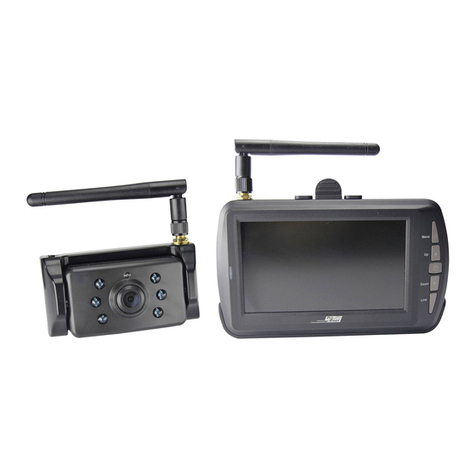
pro user
pro user DRC4340 User manual
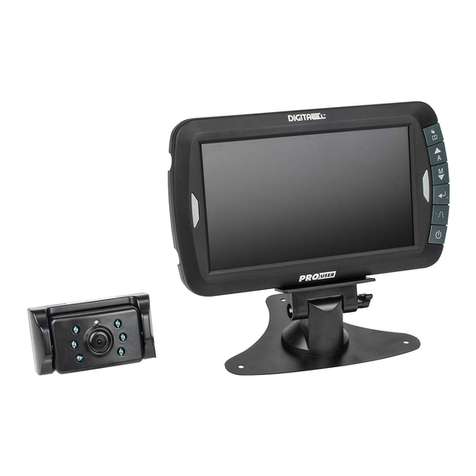
pro user
pro user DRC7010 User manual
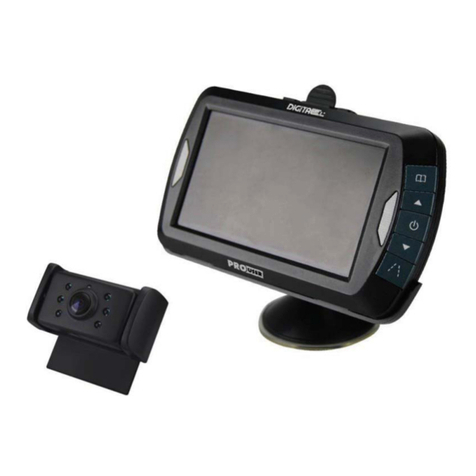
pro user
pro user DRC4311 User manual

pro user
pro user RVC3110 User manual
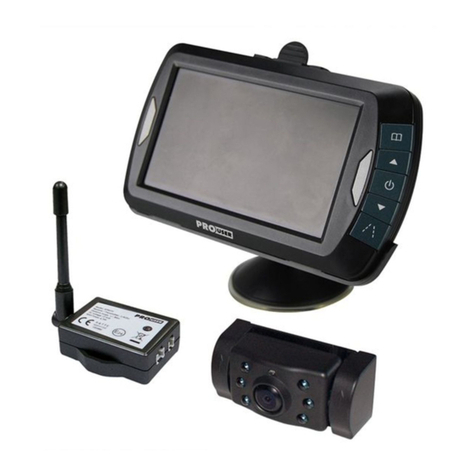
pro user
pro user APR043 User manual
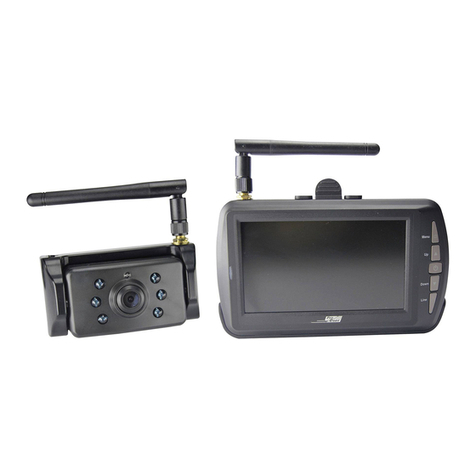
pro user
pro user DRC4340 User manual
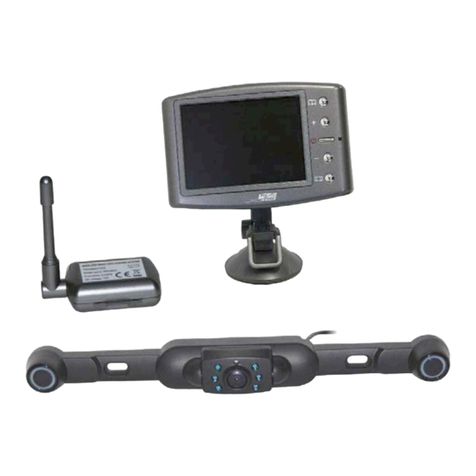
pro user
pro user RPC3600 User manual
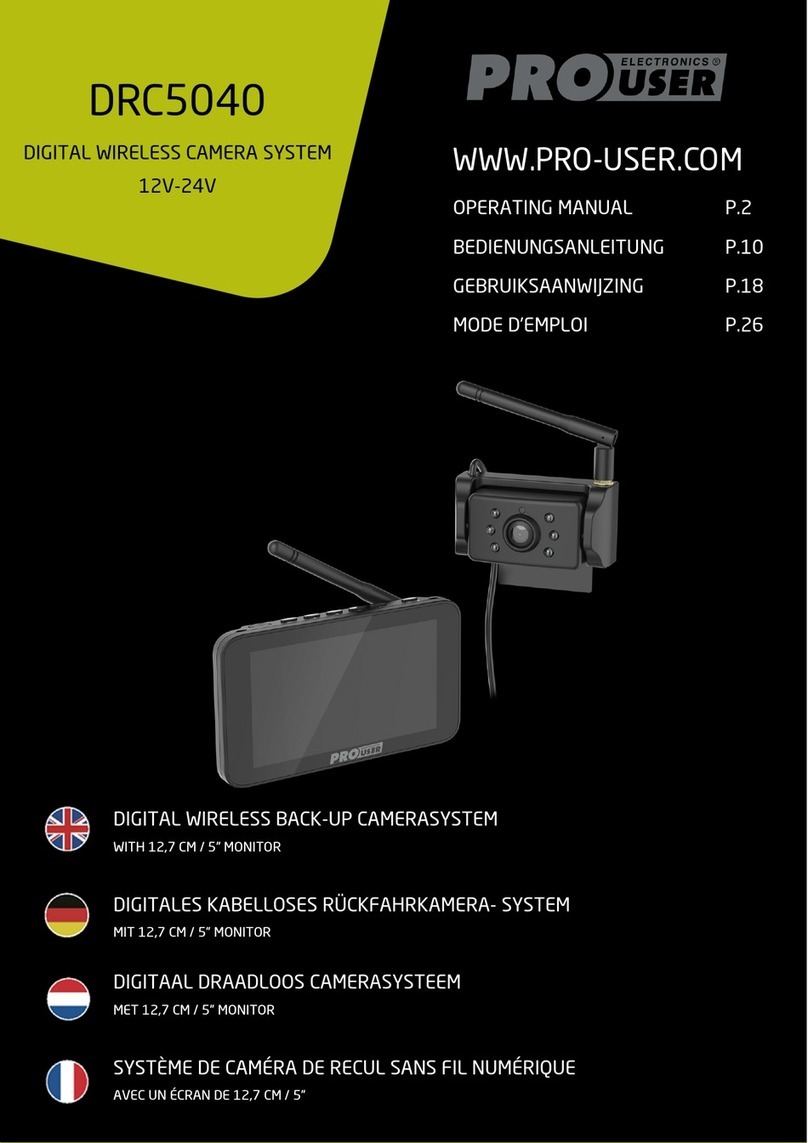
pro user
pro user DRC5040 User manual
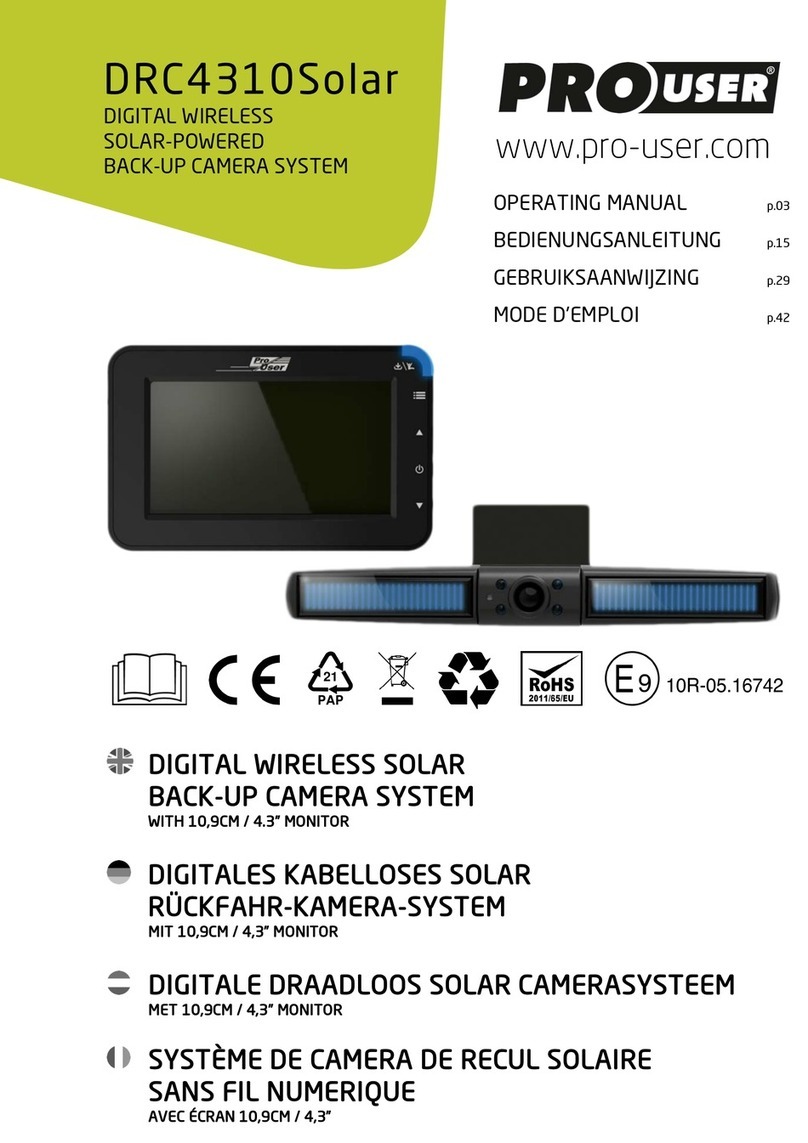
pro user
pro user DRC4310Solar User manual

pro user
pro user DRC4340 User manual
